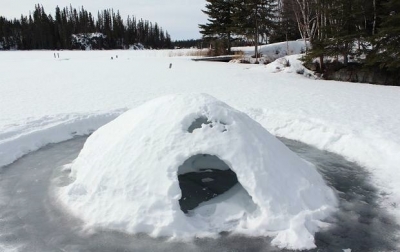
Even though stone and wooden houses have become more popular among the Eskimos, they still construct the igloo for special occasions or while on a journey. It is quickly built and defies any kind of weather. First a trench is cut about 5 feet long and 20 inches deep in a newly made snowdrift. Then, from the face of the trench, blocks are cut with a knife. These are shaped so that they lean inward when set on edge. Circles of these snowblocks are laid and the cracks are filled in with soft snow. When the igloo is complete they light a blubber lamp and make it burn as hot as possible. Then the door is closed with a block of ice and the snow begins to melt. When the door is opened and the intensely cold air rushes in, the house is transformed from a fragile building of snow to a dome of ice.
Of course, when the winter ends and the temperature rises, the igloo does begin to melt, and it is usually the roof which first caves in.
|
Fact File: An igloo becomes so solid and hard after the inside has been partly melted by the blubber lamp that a polar bear could crawl over the roof without breaking it. A small igloo can be built in a couple of hours. |
Picture Credit : Google

